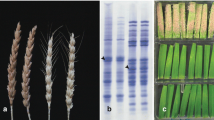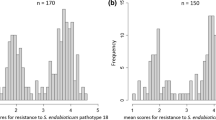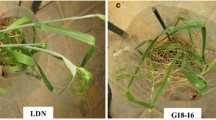Abstract
Phytophthora infestans (Mont.) de Bary is the most important fungal pathogen of the potato (Solanum tuberosum). The introduction of major genes for resistance from the wild species S. demissum into potato cultivars is the earliest example of breeding for resistance using wild germplasm in this crop. Eleven resistance alleles (R genes) are known, differing in the recognition of corresponding avirulence alleles of the fungus. The number of R loci, their positions on the genetic map and the allelic relationships between different R variants are not known, except that the R1 locus has been mapped to potato chromosome V The objective of this work was the further genetic analysis of different R alleles in potato. Tetraploid potato cultivars carrying R alleles were reduced to the diploid level by inducing haploid parthenogenetic development of 2n female gametes. Of the 157 isolated primary dihaploids, 7 set seeds and carried the resistance alleles R1, R3 and R10 either individually or in combinations. Independent segregation of the dominant R1 and R3 alleles was demonstrated in two F1 populations of crosses among a dihaploid clone carrying R1 plus R3 and susceptible pollinators. Distorted segregation in favour of susceptibility was found for the R3 allele in 15 of 18 F1 populations analysed, whereas the RI allele segregated with a 1:1 ratio as expected in five F1 populations. The mode of inheritance of the R10 allele could not be deduced as only very few F1 hybrids bearing R10 were obtained. Linkage analysis in two F1 populations between R1, R3 and RFLP markers of known position on the potato RFLP maps confirmed the position of the R1 locus on chromosome V and localized the second locus, R3, to a distal position on chromdsome XI.
Similar content being viewed by others
References
Black W, Mastenbroek C, Mills WR, Peterson LC (1953) A proposal for an international nomenclature of races of Phytopthora infestans and of genes controlling immunity in Solanum demissum derivatives. Euphytica 2:173–240
Carroll CP, Low RJ (1975) Flowering behaviour and seed fertility in dihaploid Solanum tuberosum. Potato Res 18:416–427
Carroll CP, Low RJ (1976) Aspects of male fertility in group Tuberosum dihaploids. Potato Res 19:109–121
Flor HH (1942) Inheritance of pathogenicity in Melampsora lini. Phytopathology 32:653–669
Flor HH (1971) Current status of the gene-for-gene concept. Annu Rev Phytopathol 9:275–296
Ganal MW, Young ND, Tanksley SD (1989) Pulsed field gel electrophoresis and physical mapping of large DNA fragments in the Tm-2a region of chromosome 9 in tomato. Mol Gen Genet 215:395–400
Gebhardt C, Ritter E, Debener T, Schachtschabel U, Walkemeier B, Uhrig H, Salamini F (1989) RFLP analysis and linkage mapping in Solanum tuberosum. Theor Appl Genet 78:65–75
Gebhardt C, Ritter E, Barone A, Debener T, Walkemeier B, Schachtschabel U, Kaufmann H, Thompson RD, Bonierbale MW, Ganal MW, Tanksley SD, Salamini F (1991) RFLP maps of potato and their alignment with the homeologous tomato genome. Theor Appl Genet 83:49–57
Gebhardt C, Ritter E, Salamini F (1993) RFLP map of the potato. In: Vasil IK, Phillips RL (eds) Advances in cellular and molecular biology of plants, vol I: DNA-based markers in plants. Kluwer Academic Publishers, Dordrecht, The Netherlands (in press)
Giese H, Jorgensen JH, Jensen HP, Jensen J (1981) Linkage relationships of ten powdery mildew resistance genes on barley chromosome 5. Hereditas 95:43–50
Görg R, Hollricher K, Schulze-Lefert P (1993) Functional analysis and RFLP-mediated mapping of the Mlg resistance locus in barley. Plant J 3:857–866
Hermsen JGT, Verdenius J (1973) Selection from Solanum tuberosum group phureja of genotypes combining high-frequency haploid induction with homozygosity for embryo spot. Euphytica 22:244–259
Hutten RCB, Scholber EJMM, Hermsen JGT (1990) Analysis of dihaploid production and incubation ability and tetraploid X pollinator interaction. 11th Triennial Conference EAPAR, Edinburg, UK, pp 117–118
Islam MR, Sheperd KW, Mayo GME (1989) Recombination among genes at the L group in flax conferring resistance to rust. Theor Appl Genet 77:540–546
Jacobsen E, Hovenkamp-Hermelink JHM, Krijgshield HT, Nijdam H, Pijnacker LP, Wilthoult B, Feenstra WJ (1989) Phenotypic and genotypic characterization of an amylose-free starch mutant of potato. Euphytica 44:43–48
Jahoor A, Fischbeck G (1987) Genetical studies of resistance of powdery mildew in barley lines derived from Hordeum spontaneum collected from Israel. Plant Breeding 99:265–273
Leonards-Schippers C, Gieffers W, Salamini F, Gebhardt C (1992) The R1 gene conferring race-specific resistance to Phytophthora infestans in potato is located on potato chromosome V. Mol Gen Genet 233:278–283
Malcolmson JF, Black W (1966) New R genes in Solanum demissum Lindl. and their complementary races of Phytophthora infestans (Mont.) de Bary. Euphytica 15:199–203
Mastenbroek C (1953) Experiments on the inheritance of blight immunity in potatoes derived from Solanum demissum Lindl. Euphytica 2:197–206
Mayo GME, Sheperd KW (1980) Studies of genes controlling specific host-parasite interactions in flax and its rust. Heredity 44:211–227
Mooi JC (1965) Experiments on testing field resistance to Phytophthora infestans by inoculating cut leaves of potato varieties. Eur Potato J 8:182–183
Ritter E, Gebhardt C, Salamini F (1990) Estimation of recombination frequencies and construction of RFLP linkage maps in plants from crosses between heterozygous parents. Genetics 125:645–654
Ross H (1986) Potato breeding-problems and perspectives. J Plant Breeding Suppl 13
Saxena KMS, Hooker AL (1968) On the structure of a gene for disease resistance in maize. Proc Natl Acad Sci USA 61:1300–1305
Segal G, Sarfatti M, Schaffer MA, Ori N, Zamir D, Fluhr R (1992) Correlation of genetic and physical structure in the region surrounding the I2 Fusarium oxysporum resistance locus in tomato. Mol Gen Genet 231:179–185
Stam P, Zeven AC (1981) The theoretical proportion of the donor genome in near-isogenic lines of self-fertilisers bred by backcrossing. Euphytica 30:227–238
Tanksley SD, Ganal MW, Prince JP, de Vicente MC, Bonierbale MW, Broun P, Fulton TM, Giovannoni JJ, Grandillo S, Martin GB, Messeguer R, Miller JC, Miller L, Paterson AH, Pineda O, Ruder MS, Wing RA, Wu W, Young ND (1992) High density molecular linkage maps of the tomato and potato genome. Genetics 132:1141–1160
Toxopeus HJ (1954) Leaf testing as a method of genetical analysis of immunity from Phytophthora infestans in potatoes. Euphytica 3:233–240
Umaerus V (1969) Studies on field resistance of Phytophthora infestans 1. The infection efficiency of zoospores of P. infestans as influenced by the host genotype. Z Pflanzenzücht 61:29–45
Wastie RL (1991) Breeding for resistance. In: Ingram DS, Williams PH (eds) Advances in Plant Pathology, vol 7: Phytophthora infestans, the cause of late blight of potato. Academic Press, London, San Diego, New York, Sydney, Tokyo, Toronto, pp 193–223
Author information
Authors and Affiliations
Additional information
Communicated by J. Schell
Rights and permissions
About this article
Cite this article
El-Kharbotly, A., Leonards-Schippers, C., Huigen, D.J. et al. Segregation analysis and RFLP mapping of the R1 and R3 alleles conferring race-specific resistance to Phytophthora infestans in progeny of dihaploid potato parents. Molec. Gen. Genet. 242, 749–754 (1994). https://doi.org/10.1007/BF00283432
Received:
Accepted:
Issue Date:
DOI: https://doi.org/10.1007/BF00283432




